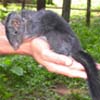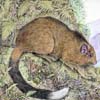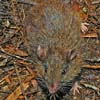Rodents — especially those found thriving amongst sewers and subway tracks — are regarded by many as the cockroaches of the mammal world. But here at Miller-McCune.com, we hold mice, rats and the rest of their furry relatives in high esteem for the insights they provide on issues ranging from disease identification and treatment to psychology and behavior.
Which is why it is exciting to report that there are apparently more rodent species on the planet than we thought.
Although nearly 1.8 million species of organisms have been identified on planet Earth, scientists believe there are millions more yet to be discovered. In fact, the International Institute for Species Exploration at Arizona State University found that in 2007 alone more than 18,500 new species were described in science literature. But — in an illustration of how rare it is to find new mammals much less rodents — only 219 species were classified as mammals, and nearly 80 percent of these were described from fossil specimens, not live animals.
And yet, according to a review published in a March edition of the Proceedings of the National Academy of Sciences, 174 of the 408 living mammal species discovered since 1993 have been rodents. That number, say authors Gerardo Ceballos and Paul Ehrlich, is particularly significant because it is higher than expected given the order’s known species richness.
Below, for Today in Mice, Miller-McCune unveils some of these rare and recently revealed rodents.
One particularly exciting recent rodent discovery was that of the Laotian rock rat, which, until it was found for sale at a Laos food market in 2005, scientists believed had gone extinct nearly 11 million years ago (how’s that for species persistence?). It wasn’t until 2006 that retired Florida State University researcher David Redfield, working with local trappers, was able to catch a live specimen of the rodent.

Named for its limestone habitat in central Laos and its rat-like whiskers and eyes, the Laotian rock rat is roughly the same size as a squirrel and has a similarly bushy tail. The animal also walks in a ‘duck waddle’ fashion, leading researchers to believe it is not adapted to climb trees. Referred to as a “living fossil,” the discovery of the Laotian rock rat was one of 1,068 new plant and animal species identified in Mekong River basin between 1997 and 2007.
Isothrix barbarabrownae is one of four new rodent species discovered in the Manu National Park and Biosphere Reserve Mountains in Southern Peru in 1999 and first describe as a new species in 2007. It lives in the 6,200-foot elevation cloud forests of the Andes Mountains. Despite three seasons of field research, Bruce Patterson of The Field Museum in Chicago and his international research team were unable to locate and observe more than one specimen of the nocturnal species. While similar in size to the Laotian rock rat, I. barbarabrownae, named after Barbara E. Brown, who has worked at The Field Museum since 1970, is an aboreal (tree-inhabiting) species that is closely related to animals called spiny rats, and likely feeds on seeds, berries and small insects. “The new species is not only a handsome novelty,” Patterson said in a press release when the study was published. “Preliminary DNA analyses suggest that its nearest relatives, all restricted to the lowlands, may have arisen from Andean ancestors. The newly discovered species casts a striking new light on the evolution of an entire group of arboreal rodents.”

Another mountain rodent recently discovered was the Batomys hamiguitan, or the Hamiguitan hairy-tailed rat. Described in Proceedings of the Biological Society of Washington in 2008, the yellow-brown animal with a long furry tail was first discovered on Mindanao Island’s Mount Hamiguitan in 2006. Weighing only about 175 grams, the Hamiguitan hairy-tailed rat is similar to four other Batomys species in the Mindanao region but is genetically distinct. While other rodents in the Batomys genus are widely distributed throughout the Phillippines, the discoverers of the Hamiguitan hairy-tailed rat believe it is the only mammal from Mindanao to be individually unique to Mount Hamiguitan — meaning the only place it can be found in the world is in its 3.9 square mile pygmy forest habitat

In June 2007, a Conservation International research team discovered a real “rodent of unusual size” when they found what they believe is a new species of Mallomys giant rat deep in the Foja Mountian forests of Papua, the largest province of Indonesia. (The misty, relatively untouched tropical forests of the area have been dubbed “the lost world” because of the number of new species discovered there in 2005.)

The rodent, having entered the scientists’ camp on several occasions, appears to lack any fear of humans, and, at a length of nearly 2 feet, is almost five times the size of the average city rat. A relatively recent discovery, the Conservation International researchers are still in the process of describing the animal as an official new species — a process that can take between two and 14 years (and sometimes longer).
OK, so technically it’s no longer an existing species, but isn’t exciting to know that a rodent the size of a bull once roamed the earth? The one ton (2,200 pound) Josephoartigasia mones — which lived sometime between 2 and 4 million years ago – currently holds the title of world’s largest living or extinct rodent.
Discovered in Uruguay in 1987 but not officially described as a species until 2008, scientists believe the large rodent likely fed on fruit and aquatic plants. Climate change and competition with other large species that migrated to South America once the Panama land bridge formed 3 million years ago are assumed to have contributed to the extinction of the J. mones; and while it looked like a large capybara, researchers believe the rodent’s closest living relative is the rare, South American pacarana.
So while between 50 and 150 species of animal are estimated to go extinct every day, here at Miller-McCune we’re hoping the new rodent discoveries just keep coming. And if they do, we’ll be sure to pass them along to you in Today in Mice.
Sign up for our free e-newsletter.
Are you on Facebook? Become our fan.
Follow us on Twitter.




